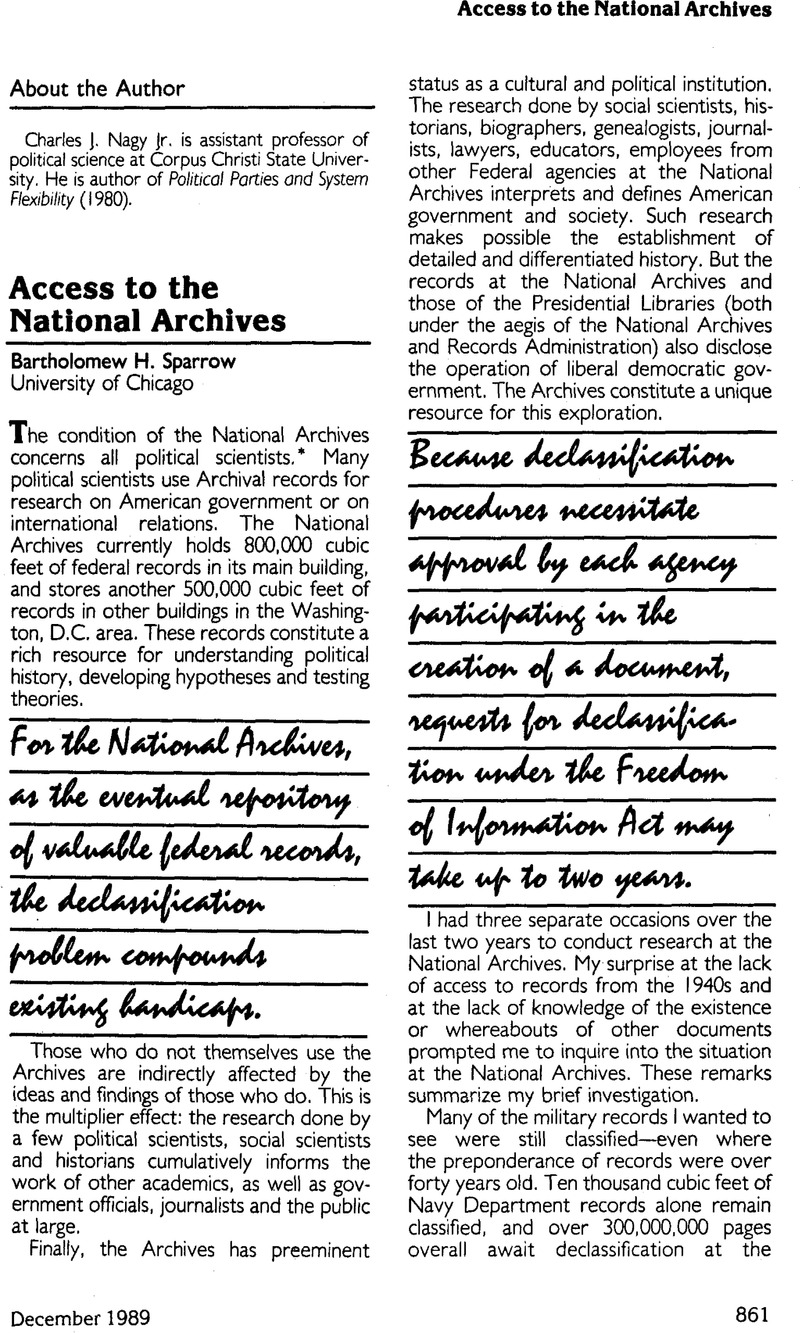No CrossRef data available.
Published online by Cambridge University Press: 02 September 2013

* I would like to thank Page Putnam Miller, Director of the National Coordinating Committee for the Promotion of History (NCC) and Jill D. Brett, Public Affairs Officer of the National Archives and Record Administration, for their generous assistance and cooperation. I am also indebted to the others at the National Archives who assisted me.
1. The “Resolution on Declassification Policy” of April 3, 1987, issued by the Policy Board of the NCC, gave evidence of the seriousness of the classification problem:
• The Stilwell Commission, established by the Department of Defense, concluded in its 1986 report Keeping the Nation's Secrets that “Too much information appears to be classified and much at higher levels than is warranted.”
• In 1986 the Information Security Oversight Office recommended to the National Security Council that steps be taken to reduce unnecessary classification and to increase the professionalism and accountability of security personnel.
• The House Permanent Select Committee on Intelligence in a February 4, 1987 report calls for the reduction of classified information, noting that overclassification “damages the credibility of appropriately classified information.”
2. EO 12356 also set up the Information Security Oversight Office, which oversees the security of records produced by over 70 departments, individual agencies and offices of the Executive branch.
3. According to the “Briefing Sheet of December 8, 1988,” of the NCC: “in the 1970s, the number of pages reviewed for declassification consistently exceeded 30 million, reaching 52 million in 1975 and 90 million in 1980; but in the 1980s the totals have dropped to 11 million and 13 million. Likewise, the numbers of pages declassified by the State Department for comparable projects decreased approximately sevenfold following the implementation of the Reagan Executive Order.”
4. The National Archives appropriation for FY 1990 is $126.6 million. The National Archives and Records Administration was not an independent agency until 1985. Before then, the NARA was part of the General Services Administration.
5. Because some records may be “bulk” declassified, requests for declassification may be handled quickly for the individual researcher: my request for approximately 25 linear feet of the Navy's Bureau of Aeronautics records (not under the FOIA) took less than two weeks to process. For more sensitive records, this procedure would, of course, not work.
6. The National Archives and Record Administration, Annual Report for the Year Ended September 30, 1988. Washington, D.C., p. 89 Google Scholar, Appendix “C.” After next year, the Archives will be working on a computerized system available to the public for tracking FOIA requests.
7. Ninety percent of FOIA requests are for documents over 30 years old. FOIA requests are also unsatisfactory for much research: historians may not know what records they need on a subject. The researcher accordingly needs comprehensive access to records, and cannot select specific documents for an FOIA request in advance (“NCC Briefing Sheet—December 8, 1988”).
8. “Archives II” will be located on a 37-acre plot on the edge of a golf course. The architects are Hellmuth, Obata & Kassabaum; the engineers are Ellerbe Becket. 1988 estimates for the cost of Archives II came to $206 million.
9. “Remarks of Don W. Wilson, Archivist of the United States to the Staff of the National Archives March 31, 1988, Third Anniversary of Independence”; “Walter Rundell Lecture” given by Don W. Wilson, Archivist of the United States, April 27, 1989.
10. My experience did not involve electronic records, but with the advent of electronic storage and retrieval systems, NARA and the Office of Management and Budget are aware of the problems attendant with such new technology. Indeed, in his address of March 31, 1988, U.S. Archivist Wilson listed computational concerns and machine readable records as his third chief concern. An Electronic Records Conference was convened and submitted recommendations to the President's Council on Management Improvement.
11. “Talking Points for Initial Efforts Toward Strengthening Declassification Policy,” June 13, 1989. National Coordinating Committee.
12. Don W. Wilson, Walter Rundell Lecture, April 27, 1989. The NCC estimates that about one-third of the records are insufficiently described. “NCC Briefing Sheet—March 16, 1989.”
13. “Remarks of Don W. Wilson,” March 31, 1989.
14. “NCC Briefing Sheet—March 16, 1989,” National Coordinating Committee.
15. “NCC Briefing Sheet—March 16, 1989,” National Coordinating Committee. The American system does have its advantages. NARA allows researchers up to 21 boxes of records at one point of time and are open from 8:45 to 10:00 PM. Copies may be done by the researcher and cost 10¢ each. In Canada, records cost 20¢, and have to be copied by staff, thus causing a week to ten-day wait for small orders, and a four- to six-week delay for larger orders. In Great Britain, records cost about 60¢ per page to reproduce; building hours are only 9:30 to 5:00 PM, Monday through Friday. On the other hand, the finding aids are computerized and the records are quickly available.
16. The pertinent Congressional committees are the House and Senate Appropriations Sub-committees on Treasury, Postal Service and General Government.
17. “Developing a Premier National Institution: A Report From the User Community to the National Archives,” by Page Putnam Miller, Director of the National Coordinating Committee for the Promotion of History. (Single copies of the report are available free by writing: Page Putnam Miller, NCC, 400 A St., S.E., Washington, D.C. 20003. Additional copies or bulk orders are 55¢ per copy.)
To their credit, officials at the Archives have acknowledged the value of Dr. Miller's frank and frequently critical assessment of the operation and administration of the National Archives. The National Coordinating Committee is a consortium of over fifty historical, archival, political, library, and genealogical organizations (including the APSA).
18. “Developing a Premier Research Institution,” pp. 5, 36.
19. “Remarks of Don W. Wilson,” March 31, 1988.”
20. Don W. Wilson, Walter Rundell Lecture, April 27, 1989; National Archives and Record Administration 1988, Annual Report, p. 3 Google Scholar.